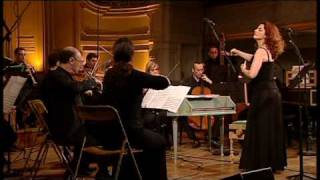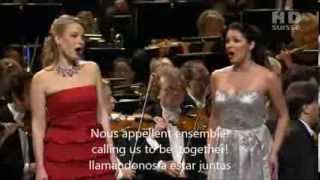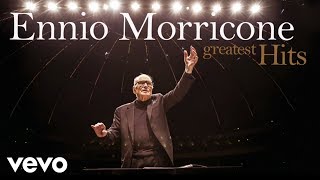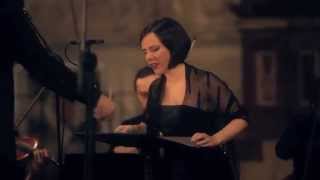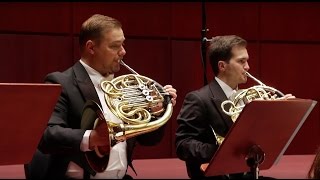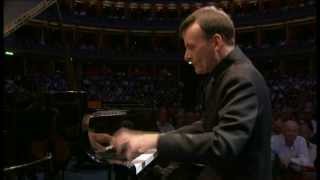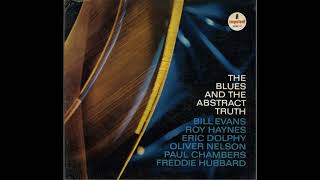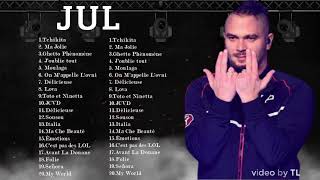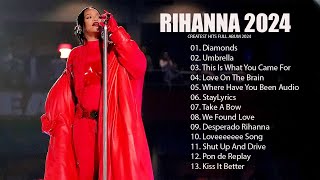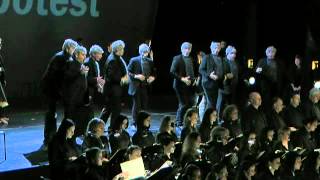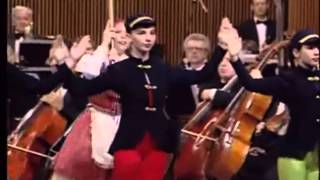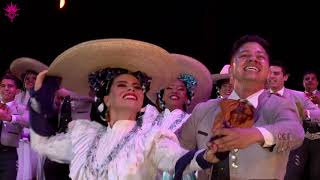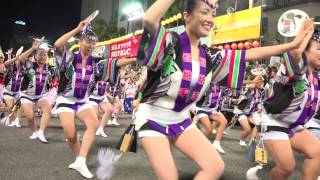Recommended music videos for initiation to classical music
Georg Friedrich Haendel ( 1685-1759) was born in Halle , Germany. He became a naturalised Englishman and is one of the greatest figures in the history of music , including the Baroque . His most notable musical work is the oratorio Messiah , one of the masterpieces of music history . As a child, he began to receive harmony and counterpoint lessons from Friedrich Zachow , organist in Halle , with whom he also learned to play the oboe, violin and organ. At the age of 18, he moved to Hamburg , where he wrote his first two operas. Three years later, he travelled to Florence and then to Rome . In 1710, he returned to Germany and from there to London, where he settled for life. Despite the total silence with which he protected his privacy, his homosexuality seems clear. He died at his home at the age of 74.
The catalogue of works by Georg Friedrich Händel , known by the initials HWV , which stands for Handel Werke Verzeichnis (in German, Catalogue of Handel's Works), is not arranged chronologically but thematically, by type of work or genre and according to its vocal or instrumental nature. It covers 612 works plus 25 supplements and doubtful and lost works, and was compiled between 1978 and 1986 in three volumes. The exact number of compositions is therefore difficult to specify. Its author is the musicologist Bernd Baselt .
Giulio Cesare In Egitto is an opera in three acts composed for the Royal Academy of Music, of which Handel, once settled in London , was director and for which he composed another thirteen operas. The plot deals with the love between Julius Caesar and Cleopatra .
Today we will attend the performance of the Overture in a performance of Le Concert d'Astrée conducted by the French maestro Emmanuelle Haïm .
Francisco Tárrega (1852-1909) was a virtuoso guitarist and composer (“the Sarasate of the guitar”), born in Villarreal (province of Castellón ). An accident marked his childhood, when he fell into a ditch due to the carelessness of the girl who looked after him, and his eyesight was damaged. His father, fearing that he would go blind, moved to Castellón so that he could attend music classes and earn a living as a musician. Later, in 1874, he entered the Conservatory of Madrid , where he studied composition with Emilio Arrieta . By the age of eighteen he was already giving guitar classes and giving concerts regularly. From 1880 he began his international tours, visiting cities such as Paris, Lyon and London , while his recitals around the state were countless.
Tárrega was interested in combining the romantic tendency that prevailed in classical music with popular Spanish elements. He is considered the creator of the foundations of 20th century classical guitar technique and of the growing interest in the guitar as a recital instrument. He died on December 15, 1909 in Barcelona due to a stroke at the age of 57.
Today we offer his Gran Jota Aragonesa in a version by Aldo Lagrutta on guitar.
Léo Delibes (1836 -1891) was a French Romantic composer. His mother was a musician and his grandfather an opera singer. His nephew Frédéric was the paternal grandfather of the Spanish writer Miguel Delibes . He began his musical studies at the Paris Conservatoire in 1847, where he was a pupil of Adolphe Adam . As a composer he achieved real fame in 1870 with the success of his ballet Coppélia ; among his other ballets also noteworthy is Sylvia , written jointly with Léon Minkus ; the Pizzicato from this ballet is very popular, one of Delibes ' greatest successes . He also composed several operas and operettas, a mass, a cantata and occasional music for the theatre, such as dances and ancient airs.
The Flower Duet (original French title: Duo des fleurs or Sous le dôme épais ) is a duet for soprano and mezzo-soprano from the famous opera Lakmé by Léo Delibes. Lakmé is set during the time of British Indian rule and the duet is performed in the first act, between Lakmé , a Brahmin's daughter, and her maid Mallika , when they go to pick flowers near a river; it is a barcarolle made familiar to the general public by British Airways commercials.
For today's performance, we are joined by two outstanding opera singers: Russian soprano Ana Netrebko and Latvian mezzo Elīna Garanča .
Ennio Morricone (1928-2020) was an Italian conductor and composer of more than 500 film and television scores and other symphonic and choral compositions. The son of a musician, he began studying the trumpet as a child and at the age of nine he entered the National Academy of Santa Cecilia . At the age of 18 he began writing for radio programs and, little by little, for films. The film director Sergio Leone , a childhood friend, asked him to collaborate on his films and thus they created a different model of western, the Spagetti Western . His contracts were expanded with other directors until he became one of the most appreciated soundtrack composers. Throughout his career he received important and countless awards endorsing his brilliant work.
Today we present a florilegium of some of his best-known soundtracks conducted by Morricone himself. I (0:00) The Ecstasy of Gold (The Good, the Bad and the Ugly) .- . II (3:22) The Good, the Bad and the Ugly. -. III (6:04) Once upon a Time in the West .- . IV (9:15) For a Few Dollars More. -. V (13:05) A Fistful of Dynamite .-. VI (17:43) Cinema Paradiso - Main Theme .-. VII (20:13) Chi Mai (Maddalena & Le professionel) .-. VIII (23:48) . La Califfa - The Lady Caliph / The Queen .-. IX (26:27) My Name is Nobody .-. X (29:37) L'arena (Il Mercenario - The Mercenary / A Professional Gun) .-. XI (34:23) A Monument (I Crudeli – The Hellbenders) .-. XII (36:55) Misterioso e Ostinato (Faccia a Faccia - Face to Face) .-. XIII (39:17) Un Amico (Revolver) .-. XIV (41:55) Love Theme for Nata (Cinema Paradiso) .-. XV (46:03) Romanzo (1900 - Novecento) .-. XVI (50:12) Romanza Quartiere (Quartiere).-. XVII (53:51) Il Figlio e la Nostalgia (The Law of the Desert) .-. XVIII (57:41) Ninna Nanna per Adulteri (Cuore di Mamma) .-. XIX (01:00:45) Watch Chimes - Carillon's Theme (For a Few Dollars More) .-. XX (01:01:57) Tradimento Primo (Tepepa).-. XXI (01:04:13) Run, Man, Run (The Big Gundown)
Recommended classical music videos
Giovanni Battista Pergolesi (1710 -1736) was an Italian composer, violinist and organist of the Baroque period (1600-1750). His work profoundly influenced the Neapolitan school, and served as the quintessential prototype of Italian opera. Although he never left the Italian peninsula, his fame as a composer of Italian operas soon spread. In 1746 his most famous work, La Serva Padrona (1733), premiered in Paris without great repercussion. He also composed many works of secular music and sacred music, his best-known work being undoubtedly the Stabat Mater . Suffering from health problems since childhood (it is believed that he suffered from spina bifida), Pergolesi died at the age of 26, apparently of tuberculosis.
The Salve Regina , also known as the Salve, is one of the most popular and well-known Catholic prayers to Mary, the mother of Jesus , originally written in Latin. It was initially a major antiphon and hymn. It is one of the four antiphons of the Breviary dedicated to the Virgin (the other three being Alma Redemptoris Mater, Ave Regina Coelorum and Regina Coeli ).
Today we offer it in the version presented by Silvia Frigato , winner of the International Provençal Baroque Singing Competition and a soprano who regularly collaborates with top-class international conductors, as well as singing regularly at the Teatro La Fenice in Venice , on this occasion accompanied by the L'Arco Magico Chamber Orchestra conducted by maestro Antonio Puccio .
César Franck (1822–1890) was a French composer and organist of Belgian origin. His father, Nicolas Joseph Franck , was a modest bank clerk who, at the beginning of 1835, settled in Paris with his entire family. As the Paris Conservatory did not allow foreigners to enter, he had to apply for French nationality and was thus able to enter the Conservatory on 4 October 1837, at the age of fourteen. In 1858, Franck became organist at the Church of Sainte-Clotilde , which had a magnificent Cavaillé-Coll , and where he would sit for the rest of his life. In 1872, he was appointed professor of organ at the Conservatory ; an event which finally ensured him a decent salary. In November 1890, following a traffic accident, his life came to an end.
Cyclic form is a technique of musical construction in which a theme, melody, or thematic material is used as a unifying element for several sections or movements of a musical composition. Sometimes the theme appears at both the beginning and the end, for example in Brahms 's Third Symphony . At other times it may appear in different parts, as in Berlioz 's Symphonie Fantastique . The term is usually applied to music composed from the 19th century onwards, although famous examples include Beethoven 's Symphony No. 5 , César Franck 's Symphony in D minor , Berlioz 's Symphonie Fantastique , the Piano Sonata in B minor and numerous other compositions by Franz Liszt .
The Symphony in D minor is César Franck 's most famous orchestral work and only symphony; it is the clearest example of cyclic symphonic writing in the Romantic tradition. The fact that Franck ultimately decided to compose a symphony at all is a strange occurrence, given the rarity of this musical form in the 19th-century French tradition, which viewed the symphony as an exclusive refuge for the German tradition. The reception of Franck 's symphony was greatly affected by the politicised world of French music and the anti-German sentiment aroused by the Franco-Prussian War to the point that Franck had to turn to the Conservatoire orchestra, which was obliged to perform new works by faculty members.
Structure : I (0´41´´) LENT – ALLEGRO NON TROPPO .-. II (18´37´´) ALLEGRETTO .-. III (28´15´´) ALLEGRO NON TROPPO. Today it is offered to us by the Frankfurt Radio Symphony conducted by the French maestro Marc Minkowski .
Samuel Barber (1910–1981) was an American composer of chamber and orchestral music. Considered a child prodigy, he began playing the piano at the age of six and composing at the age of seven. In 1958 he staged his first opera, and its success led to a commission for a second lyrical work, Anthony and Cleopatra , which premiered at the opening of the new Metropolitan Opera at Lincoln Center . Barber 's music is elegiac, lyrical, and refined; never abandoning the realm of tonality, he uses a dissonant, sometimes polytonal language; his orchestration is characterized by making the instruments sing. Much of his work is exuberantly melodic and has been described as neo-romantic. He died of cancer in New York in 1981.
Catalogue of Barber's works . His works are classified by their Opus number (from the Latin opus 'work'; op. abbreviation) which is a term used in music to catalogue the works of most composers since the 17th century .
Adagio for strings . At the suggestion of Arturo Toscanini he arranged the second movement of his String Quartet in B minor for orchestra, giving it the title Adagio for Strings ; he later arranged it for mixed choir, titling it Agnus Dei .
Today we will watch the orchestral version performed by the Orchestra del Teatro La Fenice conducted by the Italian maestro Beatrice Venezi (1990), head of the Scarlatti Young Orchestra .
Witold Lutosławski (1913-1994) was a Polish composer, the most important in the nation after Chopin , born in Warsaw , where he studied piano and composition. After the end of the war, he premiered his First Symphony , whose performance, branded as “elitist”, was prohibited by the political authorities and he was expelled from the Union of Polish Composers of which he was secretary for not following the “principles of socialist realism”. Despite everything, his Concerto for orchestra with the elaboration of Polish folk themes and influences of the Hungarian composer Bela Bartok deserved two state awards. He died of cancer at the age of 81.
Today we offer the video of Variations on a Theme by Paganini with the English pianist Stephen Hough (1961) and the Finnish conductor Oramo Sakari (1965)
Recommended music videos for all tastes
Oliver Nelson (1932 – 1975) was an American jazz saxophonist, clarinetist, and composer. He was born in St. Louis, Missouri , into an environment highly influenced by music: his brother was a saxophonist and his sister sang and played the piano. Nelson began studying piano at the age of six, and saxophone at eleven. While still a schoolboy, he got his first contract as a musician with Cootie Williams ' orchestra, where his brother was also a saxophonist. From 1947, he collaborated with different bands, graduating in 1958. After graduating, he moved to New York City , where he played with Erskine Hawkins and Wild Bill Davis , while working as an arranger at the Apollo Theater in Harlem . After six albums as a leader between 1959 and 1961, his great success came with the recording of the album that launched him to the top of jazz: The Blues and the Abstract Truth .
Ana Moura (1979) is an internationally renowned Portuguese fado singer. She began her recording career with Guarda-me a Vida na Mão, later recording Aconteceu ; she also sings in various nightclubs in Lisbon. She is currently considered one of the most successful fado singers of her generation and also holds the record for record sales in her country.
Fado is the most internationally known form of Portuguese music. Fado expresses life experiences through song. It is usually sung by one person alone, accompanied by the viola (Spanish guitar) and the Portuguese guitar. The most popular themes in fado are melancholy, nostalgia or short stories of daily life in poor neighbourhoods, but especially fatalism and frustration.
Jul , real name Julien Mari (Marseille, 1990), is a French rapper and singer. He released his first single, " Sort le cross vol ", in November 2013, followed in February 2014 by his first studio album, Dans ma paranoïa , the first in a prolific recording career: two albums per year since then, all of them certified at least platinum. In 2015, he left the Liga One Industry label following financial disagreements and founded his own independent label, D'or et de platine . In 2017, he received the award for best urban music album at the 32nd edition of the Victoires de la Musique for the album My World . In February 2020, he became the biggest record seller in French rap history with more than four million albums sold by the age of 30 and in just six years of career. In April 2022, he increased the figure to 5.5 million albums sold.
Hip hop music or rap is a genre of popular music developed in the United States by inner-city African-Americans in the Bronx borough of New York City in the 1970s. It consists of stylized, rhythmic music that is commonly accompanied by the action of rapping , which is a rhythmic, sung speech. It developed as part of hip hop culture , defined by four key stylistic elements: MCing/rapping, DJing/scratching (with turntables), break dancing , and graffiti writing . Other elements include sampling of beats or bass lines from records (or synthesized beats and sounds) and rhythmic beatboxing . The term "hip hop music" is often used interchangeably with the term "rap music". Rapping is a vocal style in which the artist speaks, sings, or recites rhythmically, usually to an instrumental.
Rihanna (1988) is a singer, businesswoman, fashion designer, actress, diplomat, writer, dancer and philanthropist born in Barbados . She is known for fusing Caribbean genres with pop music and for reinventing her image over the years. Her impact on popular culture has led her to become a music and fashion icon, which is why she is referred to as the Princess of R&B and Queen of Fashion . Rihanna is considered one of the most influential and successful musical artists of the 21st century . She gained worldwide fame after the release of her third studio album, Good Girl Gone Bad (2007). With more than 250 million musical productions distributed throughout her career worldwide, Rihanna is one of the best-selling artists of all time.
Recommended peculiar videos
Carl Orff (1895-1982) was a German composer whose work can be classified as a neoclassical musical work. He was best known for his Carmina Burana , a triptych of stage cantatas that also includes Catulli's Carmina and the Triumph of Aphrodite . His name has also been universally known for developing a system of musical education for children (known as the Orff method ) that has had notable results. Orff began playing the piano at the age of five and also took organ and cello lessons. However, he was more interested in composition; so from an early age Orff wrote and staged puppet plays for his family, with music for piano, violin, zither and glockenspiel to accompany his works.
Catulli Carmina (Ludi Scaenic) (Songs -or Words- of Catullus ), from which we offer a selection today, is a scenic cantata composed by Carl Orff , premiered in 1943 in Munich and based on the texts of the Latin poet Gaius Valerius Catullus (84-54 BC). It is written for two vocal soloists, mixed choir, a large percussion group and four pianos. The work experiments with the repetition of phrases and syncopated rhythms, along the lines already used in Carmina Burana , taking that game even further. This composition is another example of Carl Orff 's brilliant use of orchestra, percussion and stage action, displaying an interesting sung stage game.
Today we present a selection from the work, musically directed by Roman Válek and choreographed by Ladislava Košíková .
Zoltán Kodály (1882-1967) was a Hungarian composer who was committed to the folklore of his country (he collected more than 100,000 folk songs) and to musical pedagogy. He began his studies in Galánta and later in Budapest . In 1907 he met Debussy , whose music had a profound impact on him. He worked closely with Béla Bártok , who laid the foundations of what we now know as Musical Ethnomusicology . As a composer, he frequently used both popular melodies and scales, giving relevance to his choral works. As a pedagogue, he marked a milestone in history and his Kodaly Method , in which the voice is the main instrument, is still valid.
Háry János is a Hungarian "folk opera" (i.e. a spoken play with songs, in the manner of a Singspiel ) in four acts with music by Zoltán Kodály to a Hungarian libretto by Béla Paulini (1881–1945) and Zsolt Harsányi , based on the comic epic The Old Man (Az obsitos) by János Garai . It premiered at the Royal Opera House, Budapest in 1926. The subtitle of the piece is János Háry: His Adventures from Nagyabony to the Burgh of Vienna .
Today we present his Intermezzo Viennese Musical Clock.
Mexican regional dance aspires to be linked to tradition, the struggle for the revaluation, conservation and enrichment of the national culture and the belief that dance not only teaches a technique, a few steps; but teaches a way of life, a conception of the world, develops a sense of aesthetics, of beauty, as well as the connection with other arts with the purpose of enhancing the capacities, abilities and skills of future dancers. It also serves to express feelings, emotions and experiences of the course of life and to revive ancestral traditions and rites; as well as to celebrate important occasions for towns, colonies, families and cities of our country.
Today's Gala is brought to us by the Nuevo Jalisco Folkloric Ballet .
Japanese traditional dance refers to the various forms of dance performed in Japan. It is divided into two main forms: Odori , originating in the Edo period; and Mai , developed in western Japan . Odori developed outside the Kabuki theater stage and is more oriented toward masculine feelings; while Mai is developed in the rooms rather than on the stage, and was influenced by Noh theater. There is a variant of Mai called Kyomai or Kyoto-style dance. It was developed in the Tokugawa era during the 17th century and has a strong influence on the sophistication and glamour of the robes of the Imperial Court of Kyoto .
“Some fools dance and some fools watch. You’re a fool anyway, so why not dance?” are the words of the famous Awa Odori . This video features the dance and a 2014 interpretation inspired by its Buddhist roots. (Excerpted from the commentary at the bottom of the video)
Recommended music videos for children
Various Wikipedia articles have been used to write these texts.
The texts of Videomusicalis are written in Basque, Spanish and English.





